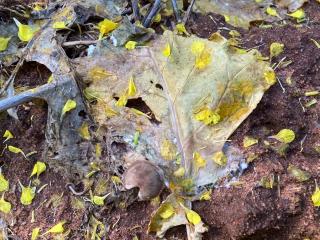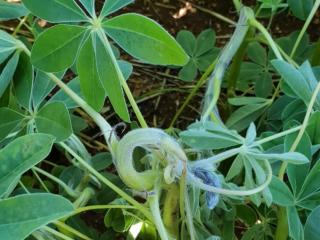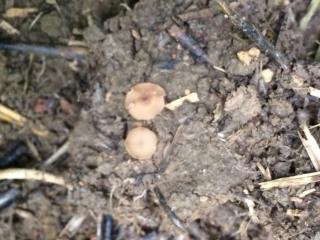Native budworm activity this week
Caterpillar activity
- Arrino
A farmer has reported high numbers of native budworm caterpillars in a lupin crop near Arrino. The caterpillars are defoliating some sections of the crop, with an estimated 6-10 caterpillars per plant.
This follows reports of some areas in the northern agricultural region experiencing native budworm moth flights in June. So these caterpillars are probably the offspring from these flights.
Pulse and canola growers in the northern agricultural region are encouraged to monitor their crops for plant feeding damage and check caterpillar numbers using a sweep net or bashing plants into a container if they are too short to sweep. Serradella, lucerne, clover and annual medic seed crops should also be regularly checked for native budworm caterpillars.
Native budworm moth trapping surveillance
Native budworm trappers who have already set up their traps all reported quite low or nil captures this week. The highest captures include: Grass Patch North (9 moths) and Southern Cross (8)
Results of this week's manual trappings are available at the department’s Native budworm moth numbers 2021.
A mapped view of the native budworm trap captures is available at Cesar Australia’s MothTrapVisWA page. Viewers need to select the desired trapping date range.
Detailed information on this pest can be found at the department’s Management and economic thresholds for native budworm.
For more information contact Alan Lord, Technical Officer, South Perth +61 (0)8 9368 3758 or +61 (0)409 689 468.
Article author: Alan Lord (DPIRD South Perth).
Anthracnose in lupins
- Northampton
Small patches of anthracnose have been found in an Albus lupin (variety Amira) paddock at Northampton. The crop is at end of flowering and subsequent to the symptoms being seen on stems fungicide has been applied.
Anthracnose is a fungal disease spread by rain-splash of spores from infected plants. The disease can affect stems, flowers and pods causing bending and twisting of the infected tissue with associated pink-orange spore masses within the lesion.
Anthracnose is favoured by wet conditions and therefore the greatest risk of disease is in high-medium rainfall areas, particularly in the Geraldton port zone where blue lupins are abundant. A period of drier weather can delay the spread of disease. Regular rainfall events this season have been ideal for the development and spread of anthracnose.
Infection usually arises from infected seed or from adjacent infected blue lupins which act as an ongoing reservoir of infection in higher rainfall northern areas.
Anthracnose infection on pods can result in pod abortion, yield loss and poor seed quality (caused by grain discolouration in severe situations).
The albus lupin variety Amira, rated as moderately susceptible (MS) to anthracnose, has improved resistance compared with older varieties Andromeda (S) and Kiev Mutant (VS) but can still suffer infection, including on pods. Most narrow leafed lupin varieties are at least MRMS to anthracnose, however infection in pods can still occur under high disease pressure.
Seed can be tested by DPIRD's Seed testing and certification services for the presence and quantity of anthracnose infection. Use of clean seed is ideal but in some circumstances (for example, resistant varieties or lower rainfall environment) low levels of seed infection can be tolerated with the use of registered seed dressing fungicide.
In high disease situations, registered foliar fungicide sprays applied at early podding on main stems and again on first order branches (if required) reduced yield loss in previous trials conducted on albus and narrow-leafed lupins. The anthracnose disease needs rain to actively spread therefore application of fungicide as a protectant prior to a significant rain event (spore spread) is most effective. Currently for albus lupin there are registration permits for a range of foliar fungicides. In narrow-leafed lupin only fungicides containing Mancozeb are registered for anthracnose. For more fungicide information refer to DPIRD’s Registered foliar fungicides for lupin in WA page.
For further information see DPIRD's Diagnosing anthracnose in narrow-leafed lupins and Lupin foliar diseases: diagnoses and management pages.
For more information contact plant pathologists Geoff Thomas, South Perth on +61 (0)8 9368 3262 or Ciara Beard, Geraldton on +61 (0)8 9956 8504.
Article authors: Geoff Thomas (DPIRD South Perth) and Ciara Beard (DPIRD Geraldton).
Sclerotinia stem rot in canola
- Geraldton
- Moora
- Dalyup
- Condingup
Plant pathologist Ciara Beard (DPIRD) has found Sclerotinia leaf symptoms, as well as white fluffy hyphae growth on the ground, in a DPIRD multi-species trial near Geraldton. Apothecia are also present on the ground nearby. The canola is finishing flowering and filling pods. Lupins in the trial are not displaying any Sclerotinia symptoms yet. In the last week, Ciara has also heard verbal reports from several agronomists of apothecia being seen for the first time this season under various crop types in the Geraldton region.


Niamh Delaney (Nutrien Ag Solutions) has found Sclerotinia stem rot on early flowering canola near Moora. Sclerotia has formed at the base of lesions. The disease Blackleg is also present in the crop.
Plant pathologist Andrea Hills (DPIRD) reports that apothecia are present in a 42Y23 canola crop near Dalyup. The crop is at stem elongation.
Quenten Knight (Agronomy Focus) has found low levels of apothecia under an early flowering Trophy canola crop near Condingup. There was no visible infection yet on canola plants. The crop will be sprayed with fungicide at 20% bloom.
Growers are encouraged to put their specific crop, soil type and general weather conditions into DPIRD’s SclerotinaCM - Sclerotinia Management decision support tool to determine the likelihood of fungicide application being a profitable exercise. For more information refer to DPIRD’s SclerotiniaCM decision support tool page.
Several fungicide products are registered for the control of Sclerotinia in canola. Fungicides need to be applied as recommended per product label, and no later than 50% bloom. For more information refer to DPIRD’s Registered foliar fungicides for canola in WA page.
To read about previous Sclerotinia activity this season refer to the 2021 PestFax articles in:
- Issue 9 Sclerotinia update
- Issue 8 More sclerotinia apothecia are germinating
- Issue 7 Sclerotinia apothecia are being found.
For more information on managing Sclerotinia refer to DPIRD’s Managing sclerotinia stem rot in canola page and GRDC’s Sclerotinia stem rot in canola factsheet.
For more information on Sclerotinia contact plant pathologists Andrea Hills, Esperance on +61 (0)8 9083 1144, Ciara Beard, Geraldton on +61 (0)8 9956 8504 or Kylie Chambers, Northam on +61 (0)8 9690 2151.
Article authors: Cindy Webster (DPIRD Narrogin) and Ciara Beard (DPIRD Geraldton).
Article input: Jean Galloway (DPIRD Northam).
PestFax continues to collaborate with Agworld, Back Paddock and Planfarm platform users
The PestFax service relies on the WA grains industry to notify us of the invertebrates and diseases that they are finding in broadacre crops and pastures – whether they know what the insect or disease is or not. In return we provide diagnoses and management advice and alert the grains industry to potential incursions. This allows growers and consultants to monitor for specific disorders and respond quickly.
The greater the number of pest, weed and disease reports that DPIRD’s PestFax receives, the more information can be compiled over time to return valuable insights to the WA grains industry via our PestFax newsletter and other communications.
Occurrences are also visually displayed on DPIRD’s PestFax map.
This reporting system also helps to validate the absence of certain invertebrates, diseases and weeds for Australian grain markets.
DPIRD has been investigating other methods of collecting field data.
This season PestFax is continuing its collaboration with companies Agworld, Back Paddock and Planfarm. All three companies have the ability to supply data from farmers, as well as agronomists, in WA to the PestFax team in a way that allows us to add value to our PestFax newsletter, map and other communications.
For consenting clients, any records entered in the Agworld, Back Paddock Adviser and Planfarm Herbicide Guide apps that contain pests, weeds or diseases and match a predetermined set of crop/pest/disease combinations are sent as anonymous reports to PestFax.
To address and allay privacy concerns, data is anonymized.
This collaboration was made possible through a competitive grant process by DPIRD’s eConnected Grainbelt project.
The PestFax team is excited to continue this collaboration and build upon this initiative in the future.
The PestFax service is the WA delivery arm of the IPMforGrains: Best Practice Insect Pest Management project. This project is delivered by the National Pest Information Network (Cesar Australia, Queensland Department of Agriculture and Fisheries (QDAF), South Australian Research and Development Institute (SARDI) and the New South Wales Department of Primary Industries (NSW DPI). This initiative is a GRDC investment and includes in-kind contributions from all project partner organisations.
For more information, or if you are interested in being involved in this collaboration, contact Art Diggle, Principal Research Officer, South Perth on +61 (0)8 9368 3563 or Cindy Webster, PestFax newsletter editor, Narrogin on +61 (0)8 9881 0201.
Article authors: Cindy Webster (DPIRD Narrogin) and Art Diggle (DPIRD South Perth).






